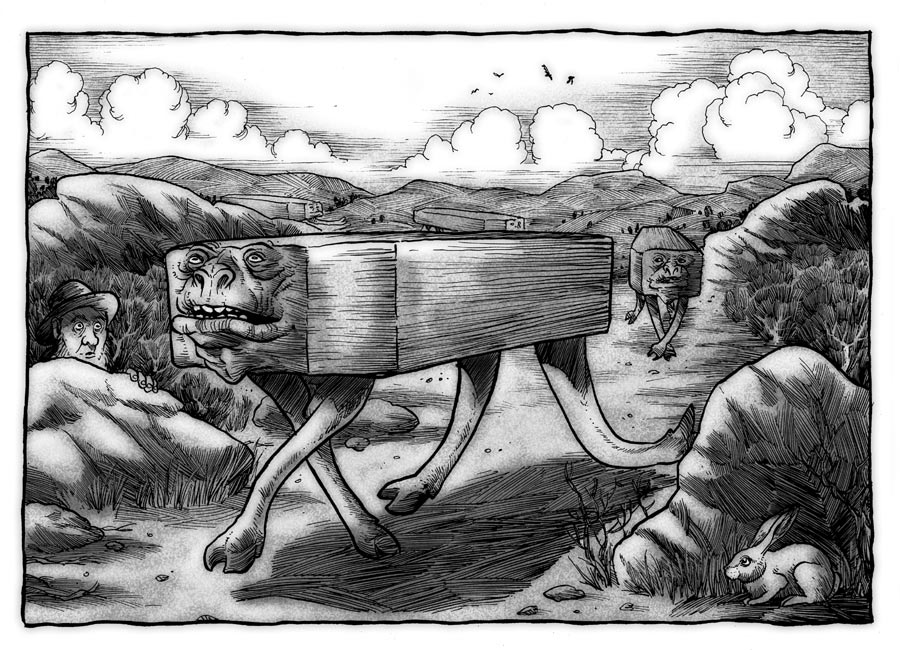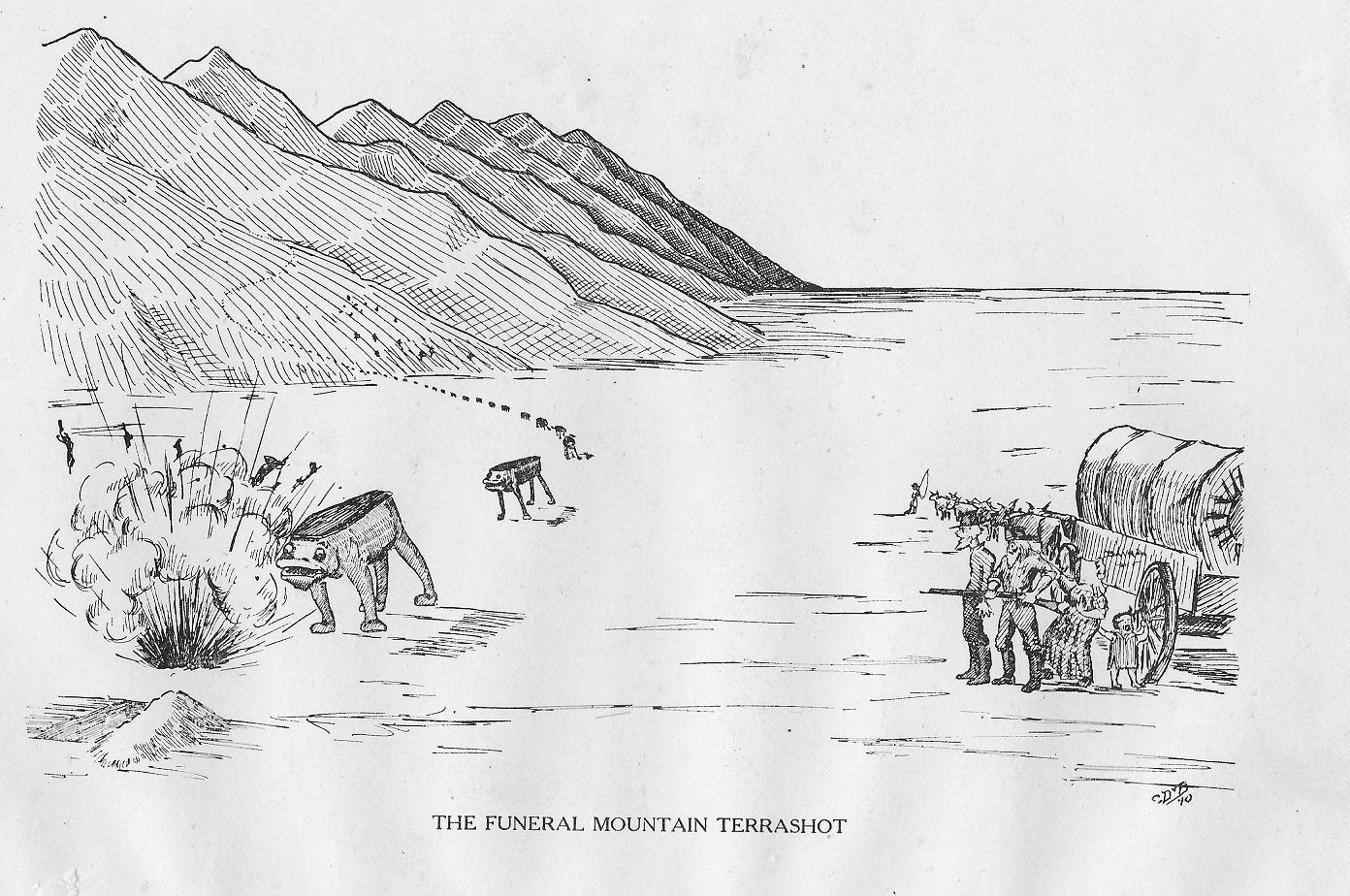Ты только представь, Странник: при сильном ускорении чебурашке закладывает 75% тела!
Bestiary.us
энциклопедия вымышленных существБыстрый переход
- Бестиарий Сапковского Бестиарий книг Анджея Сапковского о ведьмаке, волшебные существа и расы мира Геральта.
- Бестиарий «Волчонка» Материалы портала посвящены мифологии сериала "Волчонок" (Teen Wolf), различным легендам и поверьям о вервольфах и других существах, встречаемых в сериале.
- Сверхъестественное Бестиарий сериала "Сверхъестественное" ("Supernatural" series)
Похоронный горный террашот
Похоронный горный террашот — в фольклоре американских колонистов, удивительный четвероногий зверь с панцирным гробообразным телом шести-восьми футов длиной
Funeral Mountain Terrashot — according to the tales of first american lumberjacks, a strange four-legged beast with carapace casket-like body, six to eight feet long
Похоронный горный террашот — в фольклоре американских колонистов, удивительный четвероногий зверь с панцирным гробообразным телом шести-восьми футов длиной
Funeral Mountain Terrashot — according to the tales of first american lumberjacks, a strange four-legged beast with carapace casket-like body, six to eight feet long
Похоронный горный террашот — в фольклоре американских колонистов, удивительный четвероногий зверь с панцирным гробообразным телом шести-восьми футов длиной
Похоронный горный террашотВ фольклоре американских колонистов, удивительный четвероногий зверь с панцирным гробообразным телом шести-восьми футов длиной по-русскиFuneral Mountain TerrashotAccording to the tales of first american lumberjacks, a strange four-legged beast with carapace casket-like body, six to eight feet long in english
Funeral Mountain Terrashot —
Funericorpus displosissimum —
Согласно бытовавшим на рубеже XIX-XX веков байкам американских лесорубов, удивительный четвероногий зверь с панцирным гробообразным телом шести-восьми футов* длиной:
This animal explains the origin of the name of the Funeral Range, California. The creature has a casket-like body, six to eight feet long, with a shell running the whole length of its back. Its four legs are long and wobbly, causing the terrashot to sway uncertainly from side to side and forward and backward as it travels along.
The strange beast was first reported by some Mormon emigrants, who observed a peculiar procession entering the desert from a certain mountain range, afterward named the Funeral Mountains. They also witnessed the tragic fate of the creatures. One of the Mormons, aroused by his curiosity, made an investigation which resulted in finding out about all that is known of the terrashot. It seems that the animal lives in the little meadows and parks in the higher portions of the range, where it gradually increases in numbers, until by a strange impulse it is seized by a desire to emigrate. They then form long processions and march down into the desert, with the evident intention of crossing to other ranges that can be seen in the distance, but none of them ever gets across. As they encounter the hot sands they rapidly distend with the heat, and one after another they blow up with resounding reports, leaving deep, grave-shaped holes in the sand.
"Fearsome Creatures of the Lumberwoods" by William Cox (452: p.19)
От этого животного произошло название Похоронного хребта в Калифорнии. У него гробообразное тело шести-восьми футов длиной, панцирь вдоль всей спины и четыре длинные шаткие ноги. Из-за этого террашот при ходьбе непредсказуемо вихляет из стороны в сторону и вперед-назад.
Об этом удивительном звере впервые рассказали эмигранты-мормоны, наблюдавшие странное шествие, спускающееся в пустыню с горного кряжа, впоследствии и названного Похоронными горами. Они также были свидетелями трагической кончины всех животных. Любопытство побудило одного из мормонов предпринять свое расследование; почти все, что мы знаем ныне о террашоте, мы знаем в результате него. Кажется, животное обитает на высокогорных лугах и перелесках хребта, где его популяция постепенно увеличивается до тех пор, пока, по какому-то странному импульсу, террашотов вдруг не охватывает жажда перемены мест. Тогда они образуют длинные процессии и спускаются в пустыню с очевидным намерением достигнуть других хребтов, видных на далеком расстоянии. Но еще никто и никогда не смог до них добраться. Дойдя до горячих песков, они быстро раздуваются от жары и один за другим с громким хлопком взрываются, оставляя в песке глубокие ямы в форме могил.
Уильям Коск "Жуткие создания промысловых лесов". Перевод Антона Ботева (*)
According to the tales of first american lumberjacks, the Funeral Mountain Terrashot is a strange four-legged beast with carapace casket-like body, six to eight feet* long:
This animal explains the origin of the name of the Funeral Range, California. The creature has a casket-like body, six to eight feet long, with a shell running the whole length of its back. Its four legs are long and wobbly, causing the terrashot to sway uncertainly from side to side and forward and backward as it travels along.
The strange beast was first reported by some Mormon emigrants, who observed a peculiar procession entering the desert from a certain mountain range, afterward named the Funeral Mountains. They also witnessed the tragic fate of the creatures. One of the Mormons, aroused by his curiosity, made an investigation which resulted in finding out about all that is known of the terrashot. It seems that the animal lives in the little meadows and parks in the higher portions of the range, where it gradually increases in numbers, until by a strange impulse it is seized by a desire to emigrate. They then form long processions and march down into the desert, with the evident intention of crossing to other ranges that can be seen in the distance, but none of them ever gets across. As they encounter the hot sands they rapidly distend with the heat, and one after another they blow up with resounding reports, leaving deep, grave-shaped holes in the sand.
"Fearsome Creatures of the Lumberwoods" by William Cox (452: p.19)
Онлайн источникиАнлайн крыніцыŹródła internetoweОнлайн джерелаOnline sources
Статус статьиСтатус артыкулаStatus artykułuСтатус статтіArticle status:
Штучка (минимум инфы, как правило из одного источника, по существу просто попавшемуся под руку, с большой вероятностью, что больше о нем не найти)
Подготовка статьиПадрыхтоўка артыкулаPrzygotowanie artykułuПідготовка статтіArticle by:
Адрес статьи в интернетеАдрас артыкулу ў інтэрнэцеAdres artykułu w internecieАдрес статті в інтернетіURL of article: //bestiary.us/pokhoronnyi-gornyi-terrashot


Культурно-географическая классификация существ:
Культурна-геаграфічная класіфікацыя істот:
Kulturalno-geograficzna klasyfikacja istot:
Культурно-географічна класифікація істот:
Cultural and geographical classification of creatures:
Ареал обитания:
Арэал рассялення:
Areał zamieszkiwania:
Ареал проживання:
Habitat area:
Форумы:
Форумы:
Fora:
Форуми:
Forums:
Еще? Еще!
Каучпок — в фольклоре западных штатов США легковоспламеняющееся животное с каучукоподобной шкурой
Центральноамериканский винтоссер — в фольклоре американских колонистов небольшой зверь с вращающейся шарнирной головой и тремя комплектами конечностей на трехгранном теле
Триподеро — в фольклоре Американских колонистов, удивительное создание с двумя складными телескопическими ногами, кенгуровым хвостом и прицельным клювом, похожим на четырехкалиберное нарезное ружье
Хугаг — в фольклоре американских колонистов животное, напоминающее лося, но с ногами без сочленений и огромной верхней губой
Роперит — существо с арканом вместо клюва из баек и "поверьев" американских лесорубов-колонистов
Снолигостер — в фольклоре Американских колонистов прожорливый хищник наподобие лохматого крокодила без лап, с единственным шипом на спине и подобием костяного винта на хвосте
Подорожный шмыг — в фольклоре американских колонистов существо с передними лапами как у медведя, а задними — как у лося: ходит попеременно то на тех, то на других, путая лесорубов; ест потерянные вещи
Кот-расщепенец — необычайно твердолобый кот, ломающий и расщепляющий деревья в поисках своей пищи, которая состоит из пчёл и енотов
Ходаг — в фольклоре штата Висконсин довольно крупное животное неопределённого вида, по некоторым данным питающееся дикообразами и боящееся лимонов
Древоскрип — похожее на ласку существо из промысловых лесов США, трущееся о стволы деревьев и подражающее любому звуку, который издают деревья
Колотопозад — в фольклоре штатов Новой Англии пантера-людоед с шаром на конце хвоста, которым она бьёт по голове своих жертв
Бильдад — в фольклоре американских колонистов животное размером с бобра, с длинными задними лапами, как у кенгуру, перепончатыми стопами и тяжелым клювом, как у ястреба
Кактусовый кот — в фольклоре Американских колонистов обитающий в южных штатах представитель семейства кошачьих, обладающий колючей шерстью, разветвленных хвостом и необузданной страстью к ферментированному кактусовому соку
Агропельтер — в фольклоре Американских колонистов агрессивное обезьяноподобное существо, обитающее в полых стволах сухих деревьев
Снежный вассет — в фольклоре американских колонистов, опасный прожорливый хищник, обитающий под толстым слоем снега
Вапалузи — в фольклоре американских колонистов, причудливый маленький зверь, похожий на таксу с ногами дятла, перемещающийся по стволам деревьев подобно гусенице
Делювиальный болтер — в фольклоре американских колонистов, страшное горное животное с огромной рыбьей головой, с маленькими глазками и ртом, заходящим назад за линию ушей
Дисмал-соугер — в фольклоре американских колонистов жалкое и унылое млекопитающее, покрывающее себя нелепо-комичной мантией из листьев кипариса, склеенных вязкой грязью жутких болот, в которых обитает
Луска — морское чудовище, согласно креольскому фольклору, обитающее в водах Багамских островов и питающееся человеческим мясом
Барбегази — в фольклоре французов и швейцарцев крохотные существа с огромными ногами, обитатели Альпийских вершин



Comments
Отправить комментарий